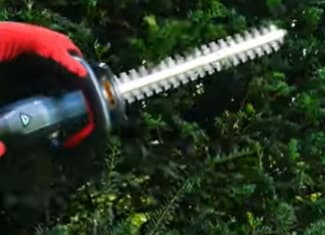As an Amazon Associate, this site earns commissions from qualifying purchases. For more information click here.
A well-manicured garden is a source of pride for any homeowner, and hedge trimmers play a vital role in achieving that pristine look. However, even the best hedge trimmers can lose their edge over time due to regular use. Dull blades not only make trimming a cumbersome task but also compromise the health and appearance of your plants. Fortunately, sharpening hedge trimmer blades with a file is a skill that any gardening enthusiast can master with the right tools and techniques.
Key Takeaways:
- Prioritize safety: Always wear gloves and safety goggles to protect yourself during the sharpening process.
- Clean thoroughly: Remove debris, sap, and rust from the blades before sharpening to achieve optimal results.
- Maintain consistency: Apply even pressure and consistent filing strokes to ensure uniform sharpening across all blade teeth.
Tools and Materials Needed:
- Hedge trimmer: Ensure it is powered off and disconnected.
- File: a flat or mill file with fine or medium grit.
- Workbench or sturdy surface: Provides a stable platform for sharpening.
- Gloves: Protect hands from sharp edges and debris.
- Safety goggles or glasses: Shield eyes from potential flying particles.
- Wire brush or steel wool: Essential for removing debris, sap, and rust.
- Lubricating oil: Helps prevent rust and reduces friction post-sharpening.
- Rags or paper towels: For cleaning and applying lubricant.
Step 1: Preparation
Begin by powering off your hedge trimmer and disconnecting it from any power source to prevent accidents. Set up a workbench or sturdy surface where you can comfortably work on the trimmer.
Step 2: Inspection
Carefully examine the blades of your hedge trimmer for any signs of damage, such as nicks or chips. Minor damage can often be remedied through sharpening, while significant damage may require blade replacement.

Step 3: Cleaning
Use a wire brush or steel wool to meticulously clean the blades, ensuring all debris, sap, and rust are removed. A clean surface is essential for achieving optimal sharpening results. Wipe the blades with a rag or paper towel to eliminate any remaining residue.
Step 4: Securing the Blade
To facilitate effective sharpening, secure the blades in place using the trimmer’s locking mechanism or clamps. This ensures stability and minimizes the risk of accidental movement during the sharpening process.
Step 5: Selecting the File
Choose an appropriate file for sharpening based on the size and condition of your hedge trimmer blades. A flat file or mill file with a fine or medium grit is typically suitable for most blades.
Step 6: Sharpening Technique
Hold the file at a consistent angle, mirroring the bevel on the blade, which is usually around 30 to 45 degrees. Employ smooth and even strokes, starting from the base of each tooth and working towards the tip. Maintain uniform pressure throughout the filing process for consistent results.
Step 7: Even Pressure
Ensure even pressure is applied to each tooth during sharpening to prevent uneven results or blade damage. Avoid excessive pressure, as it can compromise the integrity of the blade.
Step 8: Checking Sharpness
Periodically pause to assess the sharpness of the blades by running a finger lightly along the cutting edge. Exercise caution to avoid accidental cuts. Sharp blades should feel smooth and keen to the touch.
Step 9: Lubrication
After sharpening, apply a thin layer of lubricating oil to the blades to prevent rust and corrosion. Use a rag or paper towel to evenly distribute the oil across the blade surface, reducing friction during operation and prolonging blade lifespan.
Step 10: Reassembly and Testing
Carefully reassemble the hedge trimmer according to the manufacturer’s instructions, ensuring all components are properly aligned and secured. Before use, conduct a test on a small section of foliage to confirm that the blades are cutting smoothly and efficiently.
What to Look for in a Sharpening File
When purchasing a hedge trimmer sharpening file, it’s crucial to select the right tool for the job to achieve optimal results. Here’s what to look for when buying a hedge trimmer sharpening file:
File Type:
Choose a file specifically designed for sharpening garden tools, such as hedge trimmer blades. Flat files or mill files are commonly used for this purpose. Ensure the file has a fine or medium grit, which is suitable for sharpening blades without removing too much material.
Size and Shape:
Select a file that matches the size and shape of your hedge trimmer blades. The file should be slightly larger than the teeth of the blade to ensure effective sharpening. Consider the length and width of the file, as well as the shape of the filing surface, to ensure compatibility with your hedge trimmer blades.
Material and Durability:
Look for a file made from high-quality materials, such as hardened steel, for durability and longevity.
Ensure the file’s teeth are well-formed and evenly spaced to provide consistent sharpening results without causing damage to the blades.
Handle Design:
Look for a file with a comfortable and ergonomic handle that allows for a secure grip during sharpening.
Some files come with contoured handles or rubberized grips to reduce hand fatigue and improve control while sharpening.
Compatibility:
Ensure the file is compatible with the type of blade you intend to sharpen. Different hedge trimmers may have blades with varying tooth designs and sizes. Check the manufacturer’s recommendations or product specifications to ensure compatibility with your hedge trimmer model.
Ease of Maintenance:
Consider whether the file requires any special maintenance or cleaning procedures to ensure longevity and optimal performance. Files with corrosion-resistant coatings or easy-to-clean surfaces may be preferable for long-term use in outdoor environments.
Price and Value:
Compare prices and read reviews to determine the best value for your budget. While it’s essential to consider cost, prioritize quality and performance to ensure satisfactory results when sharpening your hedge trimmer blades.
By carefully considering these factors, you can confidently select a hedge trimmer sharpening file that meets your needs and ensures your garden tools remain sharp and effective for years to come.
Other Ways to Sharpen Hedge Trimmer Blades
Rotary Tool or Bench Grinder:
Use a rotary tool equipped with a grinding stone attachment or a bench grinder to sharpen the blades.
Hold the blade securely and carefully guide it against the rotating stone, maintaining the original angle of the cutting edge. Exercise caution to avoid over-grinding or heating the blade, which can damage its integrity.
Sharpening Stone:
Employ a sharpening stone specifically designed for garden tools to sharpen hedge trimmer blades.
Secure the blade on a flat surface and maintain the original bevel angle while stroking it against the sharpening stone. Utilize lubricating oil or water to facilitate smoother sharpening and prevent overheating of the blade.
Professional Sharpening Services:
Consider outsourcing the sharpening task to professional sharpening services specializing in garden tools. These services have specialized equipment and expertise to sharpen hedge trimmer blades effectively and efficiently.
While this option may incur additional costs, it ensures precise sharpening and extends the lifespan of your hedge trimmer blades. Each method has its advantages and considerations, so choose the one that best suits your preferences, skills, and available resources.
Does Your Hedge Trimmer Need Sharpening?
Recognizing when hedge trimmer blades need sharpening is essential for maintaining optimal performance and achieving clean, precise cuts. Here are some signs to look out for:
Ragged Cuts
If you notice that your hedge trimmer is producing ragged or torn cuts rather than clean, smooth edges, it’s a clear indication that the blades are dull. This can also cause vibrations in hedge trimmers.
Dull blades tend to crush foliage rather than cleanly slicing through it, resulting in uneven and unsightly cuts that can harm the health of your plants.
Increased Effort
When operating the hedge trimmer, pay attention to the level of effort required to cut through branches and foliage. Dull blades necessitate more force to achieve the same cutting results, leading to increased strain on both the operator and the trimmer motor.
Slower Cutting Speed
Sharp hedge trimmer blades effortlessly glide through branches, allowing for quick and efficient trimming. If you notice a significant decrease in cutting speed or the trimmer seems to be struggling to cut through vegetation, it’s likely time to sharpen the blades.
Wilted or Damaged Foliage
Dull blades can cause damage to the foliage, resulting in wilted or browned leaves due to crushing or tearing. Healthy plants should exhibit vibrant and evenly trimmed foliage after pruning with a sharp hedge trimmer.
Uneven Growth:
Inadequately sharpened blades may lead to uneven growth patterns in hedges and shrubs.
Uneven cuts can stimulate erratic growth, resulting in a misshapen appearance and requiring more frequent trimming to maintain desired aesthetics.
Audible Signs
Listen for any unusual noises emitted by the hedge trimmer during operation, such as grinding or screeching sounds.
These noises may indicate that the blades are struggling to cut efficiently due to dullness or damage. Regular inspection and maintenance of hedge trimmer blades are essential for ensuring optimal performance and prolonging their lifespan. By recognizing the signs of dull blades early on, you can address sharpening promptly and continue to achieve professional-quality results in your gardening endeavors.
Conclusion
Regular maintenance, including sharpening, is paramount to preserving the performance and longevity of your hedge trimmer. Remember to prioritize safety at all times by wearing gloves and safety goggles throughout the sharpening process. With practice and attention to detail, you’ll master the art of hedge trimmer maintenance and enjoy professional-quality results in your gardening endeavors.

I love the outdoors and all the tools for maintaining gardens, yards and lawns. The only thing I am more passionate about is sharing what I know about garden and outdoor equipment.


